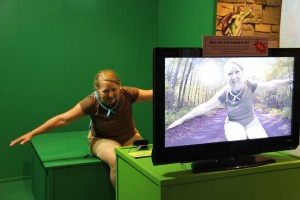Imagine being so strong you could pull a dinosaur. When I stepped on a scale at the Cable Natural History Museum in Cable, Wisconsin, I found out that if I was a dung beetle, I’d be strong enough to do just that, as dung beetles can pull up to 1,411 time their body weight. I’m glad I’m not a dung beetle, though. What a poopy life that would be! The dung beetle is one of several insects and flowers highlighted in the museum’s Nature’s Superheroes exhibit.
 Everyone who visits the museum gets a chance to be a superhero, too. As you enter the museum you are asked to don a superhero cape. This goes for adults as well as children. If you’d like, you can enter the phone booth an ordinary person and emerge as a superhero.
Everyone who visits the museum gets a chance to be a superhero, too. As you enter the museum you are asked to don a superhero cape. This goes for adults as well as children. If you’d like, you can enter the phone booth an ordinary person and emerge as a superhero.
 Skip and I chose to evolve into our superhero personae in the wide open museum lobby. I was a tree frog and skip was a dragonfly.
Skip and I chose to evolve into our superhero personae in the wide open museum lobby. I was a tree frog and skip was a dragonfly.

 What superpowers do a tree frog and a dragonfly have? Superpowers in nature are actually adaptations given to the species for survival. The tree frog can become nearly invisible, or at least blend in with the tree so well that predators don’t see it. The dragonfly flies fast, really fast, at speeds up to 30 miles per hour. Its four wings, which can each flap separately, allow them to fly in all directions. They can even do aerial stunts.
What superpowers do a tree frog and a dragonfly have? Superpowers in nature are actually adaptations given to the species for survival. The tree frog can become nearly invisible, or at least blend in with the tree so well that predators don’t see it. The dragonfly flies fast, really fast, at speeds up to 30 miles per hour. Its four wings, which can each flap separately, allow them to fly in all directions. They can even do aerial stunts.
Don’t miss a Midwest Wanderer post. For a FREE subscription, enter your e-mail address in the Subscribe2 box to the left and click Subscribe.
Among plant life, the bunchberry’s superpower is also speed, whose pollination mechanism takes less than half a millisecond, making it the fastest flower on earth.
The force behind the Nature’s Superheroes exhibit was conservation sidekick Naturalist Educator, Emily Stone. She put the exhibit together with help from staff and volunteers, creating hands-on and interactive activities that make learning fun, like the opportunity to appear on screen flying along a nature path in your superhero cape.
 Elsewhere in the museum are exhibits of species native to the area, as well as a large room used for education purposes. On the day we visited, children were making owl puppets from paper bags.
Elsewhere in the museum are exhibits of species native to the area, as well as a large room used for education purposes. On the day we visited, children were making owl puppets from paper bags.

 The museum offers over a hundred public programs throughout the year. The night before our museum visit, Skip and I participated in the museum-sponsored Owl Prowl with host naturalist Susan Thurn, where we learned to call barred owls.
The museum offers over a hundred public programs throughout the year. The night before our museum visit, Skip and I participated in the museum-sponsored Owl Prowl with host naturalist Susan Thurn, where we learned to call barred owls.
The Cable Natural History Museum will celebrate its 50th anniversary in 2017. However, its building is only five years old and very impressive. If you’re in the area, it’s a fun small museum to visit, especially if you have children.
 Afterwards, visit the museum’s property down the street, the home site of the museum’s first naturalist. The big attraction there for kids is the huge fallen limb from the oldest and largest tree on the property. Kids have enjoyed climbing on the limb for some time, so steps are now being built into the limb, and a small “fort” is being added at the base of the tree. What a fun way to adapt to nature’s occurrences.
Afterwards, visit the museum’s property down the street, the home site of the museum’s first naturalist. The big attraction there for kids is the huge fallen limb from the oldest and largest tree on the property. Kids have enjoyed climbing on the limb for some time, so steps are now being built into the limb, and a small “fort” is being added at the base of the tree. What a fun way to adapt to nature’s occurrences.
 The Cable Natural History Museum, located at 13470 County Highway M in Cable, Wisconsin, is open year round. Check the web site for exact hours and admission rates.
The Cable Natural History Museum, located at 13470 County Highway M in Cable, Wisconsin, is open year round. Check the web site for exact hours and admission rates.
Disclosure: Our trip to northern Wisconsin was hosted by the Wisconsin Department of Tourism, but any opinions expressed in this post are my own.
Thank you for reading Midwest Wanderer. Don’t miss a post. Enter your e-mail address below and click Subscribe to be notified whenever I publish another post. Subscription is FREE. After subscribing, be sure to click the link when you get the e-mail asking you to confirm. – Connie





